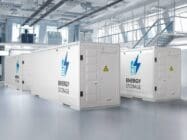
To build a successful battery supply chain, Africa needs to move away from a legacy of mineral extraction and exporting of raw materials to investing in the existing opportunity to partner, beneficiate and manufacture.
This was the consensus of panellists who participated in a discussion at the Africa Green Economy Summit in Cape Town, South Africa.
According to Marketsandmarkets, the global Battery Energy Storage System (BESS) market is expected to grow to $17.5 billion by 2028, and while Africa is looking to tap into this growing market, the continent first needs to overcome challenges to building a home-grown battery supply chain.
Mitigating cost through partnerships
Setting up a battery precursor facility is costly and one panellist who knows about that risk is Deshan Naidoo, managing director of Afrivolt.
Afrivolt is developing Africa’s first lithium-ion cell manufacturing facility with a 5GWh installed capacity. The gigafactory will likely be located in Cape Town, South Africa.
According to Naidoo, it will require about $100 million per GWh installed, which indicates the significant foreign direct investment needed to unlock this opportunity.
The good news, explained Naidoo, is that there is a lot of capital available from local and international investors and even though the cost of localising these production facilities is high, there is tremendous economic value added by localising this technology.
The key is partnerships, he said.
Naidoo explained: “We are not going to achieve this energy transition or localisation of the value chains unless we are able to achieve international technology partnerships,” adding that Africa has never been a leader in terms of technology development so an emulation strategy makes sense.
“Afrivolt has built up these partnerships around the cell manufacturing side and on the battery precursor side,” such as US partners that can tailor the cathode chemistry based on local mineral deposits.
Have you read?
Construction commences on TagEnergy’s 6th UK battery project
PowerPod proposes a blockchain-based decentralised EV charging network
Current opportunities and challenges
Panellists agreed on the importance of partnerships but identified several challenges hindering progress.
Nathan Fredericks, Industry Development Planner: Office of the COO at the Industrial Development Corporation of South Africa, stated that for an international OEM to consider partnering, policy support, evidence of supply chain, and capital must be evident.
And while the continent, and more specifically South Africa, is making headway in this regard, there is still work to be done, they agreed.
To encourage investment and development, special economic development zones are being established across Africa. These zones, according to panellists, are focus areas for investment designed to establish the infrastructure and logistics needed for effective supply chain functioning.
Maidei Matika, chief investment facilitator at GIDZ, emphasised the importance of these zones but explained that to develop facilities within them, power, water, sewage etc. are needed – and in South Africa, for example, there is a big problem with a lack of power generation capacity.
This makes it tricky, said Matika, because they are promoting investment opportunities while simultaneously finding solutions to the local challenges that ultimately hinder investment. “It’s two sides of the same coin, you are wanting a green economy and renewable energy solutions…and without that, you can’t promote the production you want to see”.
The fact that the battery value chain runs through several sectors and other value chains also brings a unique set of challenging dynamics said Fredericks, not to mention the role of geopolitics, the lack of political will and competition with China.
In terms of South Africa, added Fredericks, the country has a vibrant energy sector, good industrial roots, and demand pathways. And even though the battery industry is still nascent and skills still need to be developed, it’s possible to leverage the country’s deep industrial base to maximise local supply chain development.
A working partnership
There are examples of successful partnerships spurring the development of Africa’s battery supply chain.
Zitto Alfayo, head of project preparation at Afreximbank UK, highlighted the partnership between the Democratic Republic of Congo (DRC), home to lithium and cobalt resources, and Zambia, which is well endowed with manganese and copper.
Around 2021, explained Alfayo, as discussions about electric vehicles gained momentum across the continent, Afreximbank started exploring opportunities to start manufacturing locally, rather than merely exporting minerals abroad.
Ultimately, Afreximbank, the United Nations Economic Commission for Africa (ECA), the Democratic Republic of Congo and Zambia formed an agreement and established a special economic zone for the production of battery electric vehicles and related services.
This was a first on the continent, said Alfayo, adding that “through this kind of intervention, the cost of producing and setting up a battery precursor plant on the continent was three times cheaper than in the US or China”.
“This makes a lot of sense from an economic perspective,” he said.
Setting up a fully-fledged industrial plant via a special economic zone allows Africa to be strategically positioned up the value chain and positions the continent strategically to produce batteries for the continent and globally.
And thus far, the partnership is proving successful in that regard, said Alfayo, adding that they have recently secured international partnerships with the likes of China.
Panellists agreed that the cost and challenges are evident but the opportunities for Africa are transformational.
Concluded Alfayo: “We have all the ingredients that can power the energy transition…there is an opportunity to reimagine, reinvent and reposition how Africa goes about the energy transition.”








